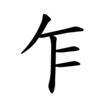Translingual
Stroke order
Han character
乍 Kangxi radical 4, 丿 +4, 5 strokes, cangjie input 竹尸 (HS ) or 人尸 (OS ), four-corner 80211 , composition ⿱𠂉 ⿰丨 二 )
Derived characters
作 , 泎 , 咋 , 怍 , 拃 , 阼 , 岞 , 妰 , 炸 , 昨 , 柞 , 胙 , 㸲 , 祚 , 砟 , 秨 , 蚱 , 舴 , 䋏 , 詐 , 酢 , 䝫 , 䟭 , 䞢 , 飵 , 鈼 , 䩆 , 鮓 , 齚 , 厏 , 岝 , 苲 , 㡸 , 怎 , 迮 , 窄 , 痄 , 笮
References
Kangxi Dictionary: page 82 , character 6
Dai Kanwa Jiten: character 130
Dae Jaweon: page 165, character 22
Hanyu Da Zidian (first edition): volume 1, page 35, character 3
Unihan data for U+4E4D
Chinese
Glyph origin
Historical forms of the character 乍
Shang
Western Zhou
Warring States
Shuowen Jiezi Han )
Liushutong (compiled in Ming )
Oracle bone script
Bronze inscriptions
Chu slip and silk script
Small seal script
Transcribed ancient scripts
j27471
j27472
j27473
j27474
j27475
j27476
j27477
j27478
j27479
j27480
j27481
j27482
j27483
j27484
j27485
j27486
j27487
j27488
j27489
j27490
j27491
j27492
j27493
j27494
j27495
j27496
j27497
j27498
j27499
j27500
j27501
j27502
j27503
j27504
j27505
j27506
j27507
j27508
j27509
j27510
j27511
j27512
j27513
j27514
j27515
j27516
j27517
j27518
j27519
j27520
j27521
j27522
j27523
j27524
j27525
j27526
j27527
j27528
j27529
b17714
b17715
b17716
b17717
b17718
b17719
b17720
b17721
b17722
b17723
b17724
b17725
b17726
b17727
b17728
b17729
b17730
b17731
b17732
b17733
b17734
b17735
b17736
b17737
b17738
b17739
b17740
b17741
b17742
b17743
b17744
b17745
b17746
b17747
b17748
b17749
b17750
b17751
b17752
b17753
b17754
b17755
b17756
b17757
b17758
b17759
b17760
b17761
b17762
b17763
b17764
b17765
b17766
b17767
b17768
b17769
b17770
b17771
b17772
b17773
b17774
b17775
b17776
b17777
b17778
b17779
b17780
b17781
b17782
b17783
b17784
b17785
b17786
b17787
b17788
b17789
b17790
b17791
b17792
b17793
b17794
b17795
b17796
b17797
b17798
b17799
b17800
b17801
b17802
b17803
b17804
b17805
b17806
b17807
b17808
b17809
b17810
b17811
b17812
b17813
b17814
b17815
b17816
b17817
b17818
b17819
b17820
b17821
b17822
b17823
b17824
b17825
b17826
b17827
b17828
b17829
b17830
b17831
b17832
b17833
b17834
b17835
b17836
b17837
b17838
b17839
b17840
b17841
b17842
b17843
b17844
b17845
b17846
b17847
b17848
b17849
s09434
Transcribed ancient scripts
L23775
L23776
L23777
References :
Mostly from Richard Sears' Chinese Etymology site (authorisation ),
Shuowen Jiezi (small seal),Jinwen Bian (bronze inscriptions),Liushutong (Liushutong characters) andYinxu Jiaguwen Bian (oracle bone script).
Old Chinese
作 *ʔsaːɡs, *ʔsaːɡs, *ʔsaːɡ
鲊 *ʔsraːʔ
痄 *ʔsraːʔ
厏 *ʔsraːʔ, *zraːʔ
詐 *ʔsraːɡs
咋 *ʔsraːɡs, *zraːɡ, *ʔsreːɡ
笮 *ʔsraːɡs, *zaːɡ, *ʔsraːɡ
榨 *ʔsraːɡs
炸 *ʔr'aːɡs, *zreːb
乍 *zraːɡs
拃 *ʔsraːnʔ
酢 *sʰaːɡs, *zaːɡ
祚 *zaːɡs
胙 *zaːɡs
阼 *zaːɡs
飵 *zaːɡs, *zaːɡ
秨 *zaːɡs, *zaːɡ
迮 *ʔsaːɡ, *ʔsraːɡ
柞 *ʔsaːɡ, *zaːɡ
昨 *zaːɡ
怍 *zaːɡ
砟 *zaːɡ
莋 *zaːɡ
岝 *zaːɡ, *zraːɡ
鈼 *zaːɡ
筰 *zaːɡ
葃 *zaːɡ, *zreːɡ, *zaɡ
舴 *ʔr'aːɡ, *ʔsraːɡ
窄 *ʔsraːɡ
蚱 *ʔsraːɡ
齚 *zraːɡ
泎 *zraːɡ
Etymology 1
Pronunciation
Baxter –Sagart system 1.1 (2014 )
Character
乍
Reading #
1/1
Modern
zhà
Middle
‹ dzræH ›
Old
/*[dz]ˁrak-s/
English
suddenly
Notes for Old Chinese notations in the Baxter–Sagart system:
* Parentheses "()" indicate uncertain presence;
* Period "." indicates syllable boundary.
Zhengzhang system (2003)
Character
乍
Reading #
1/1
No.
16650
Phonetic
乍
Rime
暮
Rime
0
Corresponding
乍
Old
/*zraːɡs/
Notes
曾 憲 通 雲 甲 金 文 象 以 耒 起 土 ,爲 耕 作 字 初 文
Definitions
(deprecated template usage ) 乍
suddenly at first ( Eastern Min ) just ; exactly ( Eastern Min ) just
Etymology 2
Pronunciation
Definitions
(deprecated template usage ) 乍
( Southern Min ) deep-fry slightly
Synonyms
Dialectal synonyms of
炸 (“to deep-fry”)
[map]
Variety
Location
Words
Formal (Written Standard Chinese )
炸 油炸
Northeastern Mandarin
Beijing
炸
Taiwan
炸
Singapore
炸
Cantonese
Guangzhou
炸
Hong Kong
炸
Singapore (Guangfu)
炸
Hakka
Meixian
炸
Miaoli (N. Sixian)
浮
Pingtung (Neipu; S. Sixian)
炸
Pingtung (Wuluo, Ligang; S. Sixian)
浮
Kaohsiung (Meinong; S. Sixian)
浮
Kaohsiung (Shanlin; S. Sixian)
浮 炸
Hsinchu County (Zhudong; Hailu)
浮
Taichung (Dongshi; Dabu)
浮
Hsinchu County (Qionglin; Raoping)
浮
Yunlin (Lunbei; Zhao'an)
糋
Eastern Min
Fuzhou
炸 浮
Southern Min
Xiamen
糋 浮 乍
Quanzhou
糋 浮 乍
Zhangzhou
糋 浮 乍
Tainan
糋 浮 乍 GT
Penang (Hokkien)
糋
Singapore (Hokkien)
糋
Manila (Hokkien)
糋
Chaozhou
炸
Wu
Shanghai
炸 氽 煠
Suzhou
氽 煠
Wuxi
煠
Hangzhou
煠 氽
Ningbo
煠 氽
Ningbo (Zhenhai)
煠
Ningbo (Fenghua)
煠
Zhoushan
煠
Note
GT - General Taiwanese (no specific region identified)
Etymology 3
For pronunciation and definitions of 乍 – see 作 get up ; to get up and go to work ; etc.”). This character is an ancient variant form of 作
Etymology 4
For pronunciation and definitions of 乍 – see 榨 press or extract juices ; to squeeze ; press to extract juices; etc.”). This character is the second-round simplified form of 榨 Notes:
Further reading
Japanese
Kanji
乍
(Hyōgai kanji )
This term needs a translation to English. Please help out and add a translation , then remove the text {{rfdef }}.
Readings
As an alternative form of 作
Korean
Hanja
乍 (eumhun 잠깐 사 ( jamkkan sa ) )
(for) a short time
References
Vietnamese
Han character
乍 : Hán Nôm chạ sạ cha sã chả
This term needs a translation to English. Please help out and add a translation , then remove the text {{rfdef }}.
References












































































































































































































